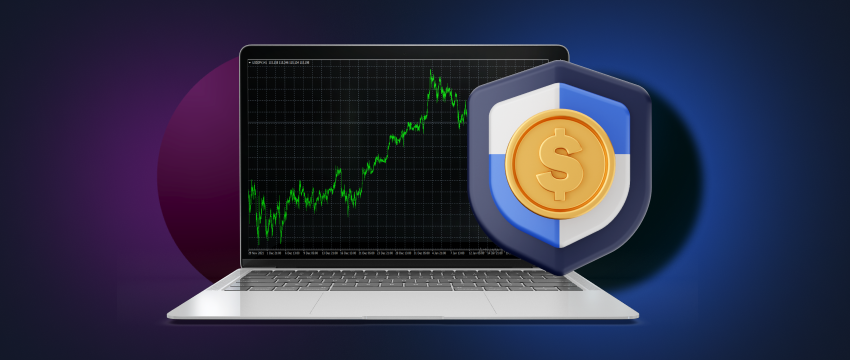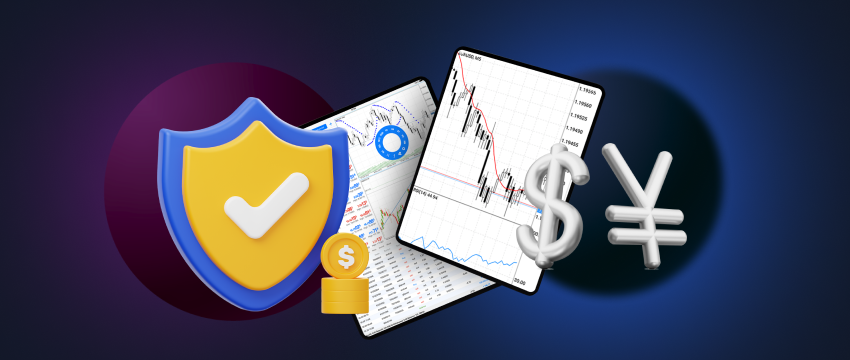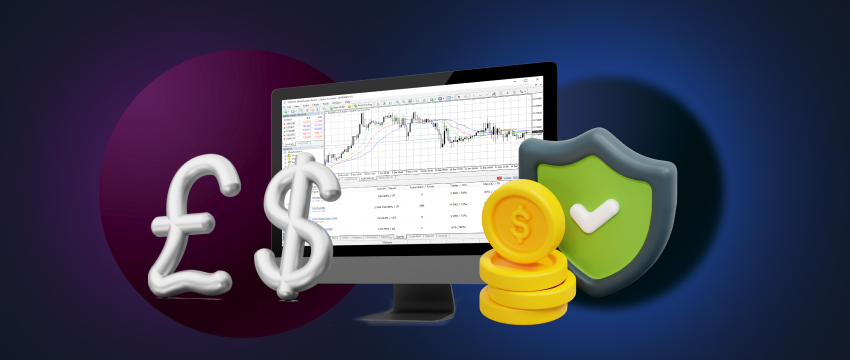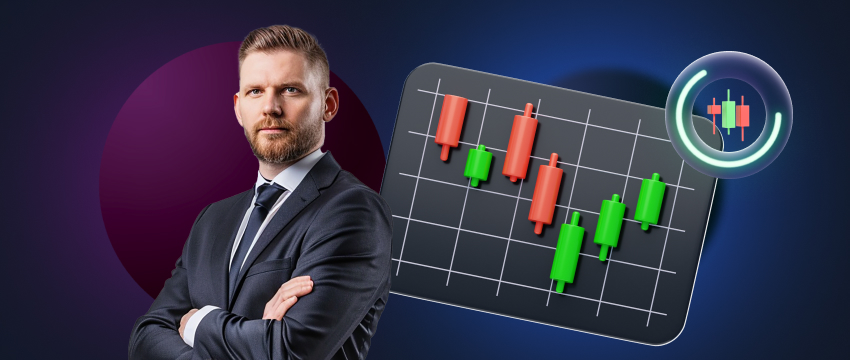Choosing a safer currency pair to trade largely depends on factors like:
- Market stability
- Investor sentiment
- Economic conditions
- Geopolitical uncertainty
- Liquidity
- Volatility
That said, traders generally consider certain currency pairs safer. The stability and economic health of the countries those currencies represent usually contribute to this perception. But, to start, let’s take a closer look at what currency pairs actually are.
Currency pair
All currency trading is done in pairs in the forex market. In other words, you have to buy one currency and simultaneously sell another.
Currencies trade in different lot sizes, and a pip represents the smallest increment of trade. The market determines the exchange rate between two currencies.
Each currency pair consists of a base currency (the first currency on the left) and a quote currency (the second currency on the right, also known as the counter currency). In other words, in the case of the EUR/USD for example, the base currency would be the EUR and the quote currency the USD.
Some of the most commonly traded pairs are called the majors. These include:
- EUR/USD (Euro/US Dollar)
- AUD/USD (Australian Dollar/US Dollar)
- USD/CAD (US Dollar/Canadian Dollar)
- USD/JPY (US Dollar/Japanese Yen)
- GBP/USD (British Pound/US Dollar)
- USD/CHF (US Dollar/Swiss Franc)
These currency pairs are some of the most popular in the world, largely due to their high liquidity and low volatility.
But what does high liquidity mean? Well, it means that there are a high volume of orders to buy and sell those pairs in the market. And an increased level of liquidity generally correlates with lower volatility. This is why these pairs are typically considered a ‘safer’ option for traders.

What moves currencies?
As previously mentioned, there are several factors affecting currency prices, thereby impacting their ‘safety’.
Let’s explore these in a little more detail.
- Supply and demand: for example, when more dollars are required globally, the value of the dollar rises. In contrast, when too many dollars are in circulation, the price decreases.
- Economic health: currencies from countries with robust economies and higher levels of development are usually regarded as safer. This typically includes currencies like the USD, EURO, GBP, CHF, JPY, etc.
- Liquidity: as stated herein, high market liquidity generally decreases the risk of aggressive price fluctuations. The EUR/USD takes the lead with the highest liquidity, followed by USD/JPY, GBP/USD, AUD/USD, USD/CAD, USD/CHF, etc.
- Geopolitical stability: the safety of a currency is impacted by the stability of its country’s political environment. Political unrest or war often times leads to unanticipated movements or spikes in currency prices.
- Investor sentiment: rapid shifts in sentiment can lead to considerable volatility. This in turn impacts the stability and thus ‘safety’ of a currency pair. A knock on effect to this is the trading strategies investors will adopt during these turbulent periods.
- Interest rates: significantly impact currency values, influenced by central bank policies and changes in interest rates. Currencies from countries with stable interest rates are generally considered safer.
Key considerations for safe trading currency pair
Regardless of the currency pairs you wish to trade, are are certain considerations to have in mind to safeguard your capital. Remember, forex trading is not without risk, and if mismanaged, can lead to substantial losses. And this risk increases exponentially when using leverage. So, what must you be aware of?
Currency pair Risk management tools
For one, having proper risk management tools in place to protect your money is vital. This includes measures like stop-loss and take profit orders. Further, never risk more than a small percentage of your capital on a single position.
Monitoring economic news and indicators
Secondly, ensure you keep yourself informed by keeping up with economic news and indicators that may impact the currency pair/s you wish to trade. A key tool in this endeavour is using an Economic Calendar, much like the one offered by T4Trade.
The broker’s economic calendar provides real-time economic coverage enabling traders to track and react to potential market-moving events. You can filter economic events by their level of importance or by country.
Viewing the impact of similar past events enhances the monitoring of current economic events. Using T4Trade’s economic calendar, you can also map 115+ forex charts to events, map indices to events, and gain insights on historical trends and their impact on currencies.
Undertaking technical and fundamental analysis
Third, be sure to conduct technical and fundamental analysis where applicable. Both forms of analysis are key in making informed trading decisions. Technical analysis in particular is a vital tool when implementing trading strategies like scalping, swing trading or day trading. Monitor charts and indicators diligently, particularly when executing multiple trades throughout a trading day.

Portfolio diversification
Fourth, consider diversifying your portfolio to spread risk and mitigate potential losses. This means, rather than putting all your capital into a single currency pair, consider spreading that capital across several currency pairs. In that way, should one trade perform badly, you have others to fall back on.
Being mindful of exotic currency pair
Fifth, seeing as safety is what we’re most concerned about, exhibit caution if trading exotic currency pairs. Exotic currency pairs are those from emerging or smaller economics, and tend to have low liquidity and high volatility. This makes them a riskier option for trading.
Learning how to become a better trader
Regardless of the currency pairs you wish to trade, it’s essential to ensure you have effective trading-related education. Without knowledge, expertise or skill, you’ll inevitably find yourself floundering, trying to manage the complexities that come with trading. There are many ways to engage in learning, particularly today, where hundreds of thousands of resources exist online. Let’s discuss some of our favourite learning resources.
1. Registering for a demo trading account.
- A demo account is prorably one of the most practical ways to learn currency trading. The account will give you access to trading platform that offers a simulated trading environment on which to execute trades. This environment has been designed to mirror real market conditions, allowing you to get a proper feel for trading. Using virtual funds, you can attempt to open and close a variety of positions, in order to monitor performance and analyse outcomes.
- Without putting your own money at risk, you can also test multiple trading strategies to determine which one is a better fit for your risk tolerance, budget, and available time. If you sign up for a T4Trade demo trading account, you will gain access to the MetaTrader 4 trading platform, possibly the most popular platforms globally. You’ll get the chance to discover MT4’s advanced trading features, include innovative analysis tools, algorithmic trading, and so much more. Over time, once you’ve gained sufficient experience and trading acumen, you can then move on to live trading.
2. T4Trade Academy:
- T4Trade’s offers its traders abundant resources via its academy, allowing you to learn more about forex trading. The Academy offers insightful webinars, videos on demand, webinars and e-guides, all of which have been curated by the broker’s expert team of researchers. Additionally, T4Trade’s Live TV channel also offers daily, Monday to Friday commentary and live discussions. With in-depth analysis from T4Trade’s market analysts, you will be able to stay on top of market trends, learn trading tips and identify trading opportunities.

Becoming a T4Trade trader
T4Trade is a powerful international CFD broker, highly regarded by traders across the globe. The forex broker offers its traders an exceptional trading experience, complemented by a cutting-edge product offering and a high-quality multilingual customer support service that’s on hand to assist you 24/5. Traders can choose from 300+ financial instruments across 6 asset classes. This enables them to trade CFDs on a variety of currency pairs, from the majors to the minors and the exotics. T4Trade also offers flexible leverage, low spreads, quick execution of trades, and easy deposit and withdrawal of funds.
Disclaimer: This material is for general informational and educational purposes only and should not be considered investment advice or an investment recommendation. T4Trade is not responsible for any data provided by third parties referenced or hyperlinked in this communication.




